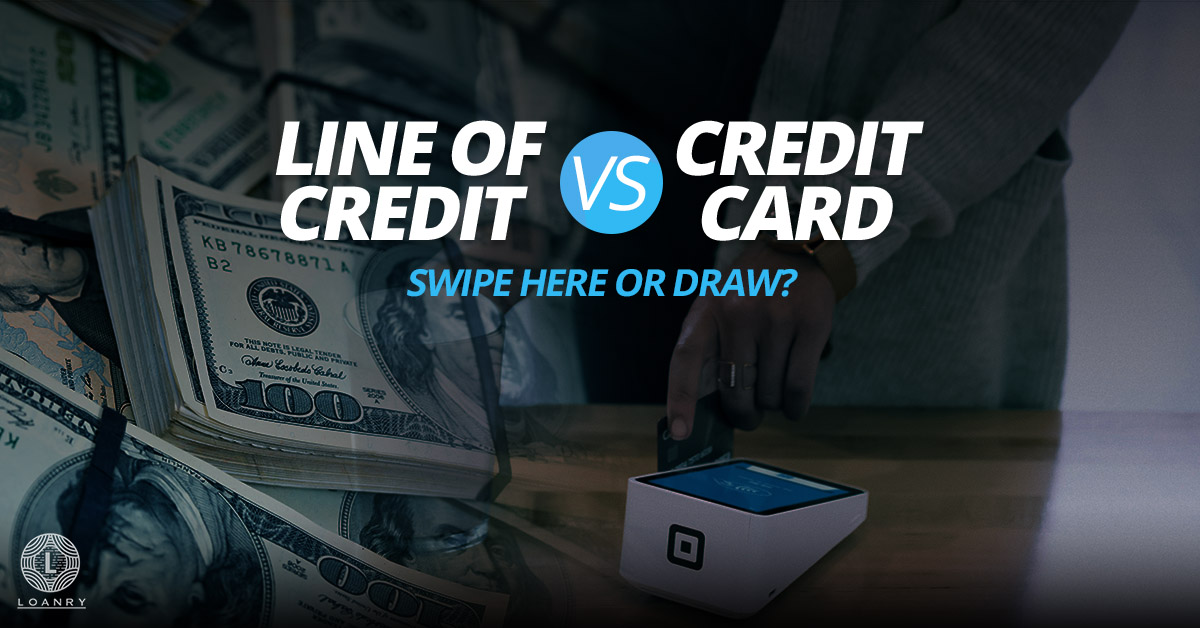
When it comes to finances, there are so many terms and definitions that it is easy to get confused. Many of these terms sound similar, and the available definitions on Google often serve to only add to the confusion. Not everyone is a finance guru, so some of us appreciate much simpler definitions. After all, how are we to know what to apply for or what we are getting into if we cannot even understand the textbook definitions?
For the moment, we are going to speak about the two often confused terms and how they differ: line of credit vs credit card. And for those of us who appreciate simplicity, we will be breaking the terms down into useful definitions and explanations. The simpler, the better, in my opinion. Let us begin.
Line of Credit VS Credit Card: Which is Better?
In truth, it is a matter of need and preference. Both offer benefits and risks. Both can be harmful and helpful. Each can be either the answer to your prayer or temptation you do not need. Either way, in order for you to choose between a line of credit vs credit card, you need to understand them on a basic level in order to make an accurate assessment. Below you will find the pertinent information needed to decide on a line of credit vs credit card.
Benefits of a Credit Card vs Line of Credit
First and foremost, the credit is available when you need it, as long as you are paying on it. You have the convenience of pulling the card out when you need it and simply swiping it. There is not waiting for the cash to be put in your hand. As long as it is available on the card, you are free to use it.
Minimum payments are usually not very high, so you probably will not have a hard time making those payments. My credit card has a minimum payment of $25 per month. Even during the tight financial months, I can usually squeeze $25 into the budget without too much stress. Also, making timely payments can improve your credit score as well as increase your credit limit on your card.
Drawbacks of a Credit Card
One of the biggest drawbacks of a credit card is that the minimum payment required is not really helping you at all. That is because the interest on credit cards is compounded. In simple terms, compounded interest means that it is added monthly. If your interest rate is 10%, your interest will be 10% of the balance on the card for that month. Next month, the interest will be calculated again, and added on top of the previous interest. So, if that is the case, what do you suppose happens if your minimum payment is lower than your interest?
In the simplest answer possible, you will dig yourself into deeper debt every single month. Let’s say you have a credit card with a $200 limit, and that card charges 20% interest. You used $150 of your available credit and your minimum payment is $25 per month. Follow along below to learn what happens if you only pay that $25 minimum.
| Month 1 | Month 2 | Month 3 | Month 4 | |
|---|---|---|---|---|
| Total Due: | $150 | $155 | $161 | %168.20 |
| Interest Rate: | 20% | 20% | 20% | 20% |
| Interest Due: | $30 | $31 | $32.20 | $33.64 |
| Total w/Interest: | $180 | $186 | $193.20 | $201.84 |
| Payment: | $25 | $25 | $25 | $25 |
| Balance: | $155 | $161 | $168.20 | $176.84 |
As you can see, your interest is higher than your payment, so paying only the minimum payment will not get you out of that debt. These numbers are just examples- yours might be higher or lower. The key to getting out of credit card debt is to always make more than the minimum payments. Many cards do not add on interest until the end of the billing cycle. If it is possible for you to pay all or at least some of your balance before then, you will save yourself some cash.
Secured VS Unsecured Credit Cards
As with most loans, there are secured and unsecured credit cards. Secured cards can be of great help to those who have no or low credit. Basically, you pay a deposit on the card, and the company issuing you the card will hold that deposit. Once they have received the deposit, they give you credit. Sometimes, you have to put up the entire amount of credit as a deposit, and sometimes it is just a portion.
For instance, if they are giving you $200 in credit, they might require that you pay as low as $50 as a deposit or may require that you pay the full $200 as a deposit. This minimizes their risk, which is why they are willing to give you credit. If you make timely payments for a set amount of time, the deposit will be returned. Also, they report to the credit bureaus. So even though the cards are secured, they can improve your credit.
Unsecured credit cards are simply approved or not according to your previous credit, your ability to repay, and your promise to pay.

What is a Line of Credit?
A line of credit is slightly different from a credit card in how it works and is given. Let’s go back to the example of you and I being besties and you needing some money. You again ask me for money but this time you have different needs. Maybe you want to take some classes at the community college and you have to pay cash. We know that the classes will cost $1,000, but we have no idea what the materials and supplies you need will cost.
This time I say, “I am going to open a bank account and put $3,000 in it. You can borrow anything you need up to that amount. I will leave that money available to you to borrow as often as you need for the next three years as long as you pay the agreed upon interest.”
You take the $1,000 for the classes and register. Two days later, you receive a list of textbooks you need to purchase and find out the total of them is $600. When classes start, you learn that there are lab fees and other costs you had no idea about. Fortunately, it is not a big deal because you still have $2,000 in the account. You take the $800 you need and leave the rest for future use.
The following month, you pay the required interest on what you have borrowed plus $200 on the principle. Now, you still have $1,600 available when you need it. Every month you pay more than the interest, you are replenishing your line of credit. Though some variables may change, this example is the basic idea of a line of credit.
Benefits of a Line of Credit vs Credit Card
One of the major benefits of a line of credit is that you have access to cash. While you can get a cash advance on a credit card, it is generally not a high amount and the interest is often higher. Plus, there are often fees for getting a cash advance. With a line of credit, the expenses associated are often lower than that of a credit card.
You also have flexible repayment options, usually from one year to more than ten years, and the APR is most often lower than that with credit cards. Lastly, there are very few restrictions, and they are an open ended credit line.
Drawbacks of a Line of Credit
First, the interest rates are usually variable, so your interest may change from month to month unlike a fixed rate loan. Lines of credit generally require an account at the financial institution you are borrowing from and a very good credit score. Additionally, you will likely find yourself paying both monthly and yearly maintenance fees so long as the line of credit is open, even if you are not using it.
Secured VS Unsecured
Most lines of credit are unsecured. This means that you provide no collateral. However, as the lending institution assumes a higher risk, it is more difficult to get a line of credit vs credit card, personal installment loan, or other loan options. If you get approved, though, you have a revolving line of credit that can be handy when you are in need.
Similarities and Differences
Now that we have broken down each separately, let’s take a closer look at which is better between a line of credit vs credit card. The two are similar in the sense that in ways, they are both lines of credit. As you generally borrow, payback, and replenish your credit card funds, it is technically a line of credit.
However, a line of credit is often much higher than a credit card. Credit cards are generally a few hundred to a couple of thousand dollar limits, though some may go higher. Lines of credit can start as low as $1,000 and go as high as the institution allows, though most cap out by $100,000. The highest most go are $25,000.
Interest Rate Differences
You will also typically notice a difference in interest rates in a line of credit vs credit card. These differences can vary widely, as well. Some credit cards offer 0% APR for the first year. With lines of credit, you begin paying interest the moment you take out any of your available credit. However, when interest rates begin, lines of credit often run from 9% to 23%.
Credit card interest rates usually start at 23%, though you may find some a little higher or lower. It is also important to remember that with a line of credit, the interest rates- unless stated otherwise- are variable. You may find yourself paying 9% one month and jolting to 23% the next. This makes it rather difficult to budget your payment.
Also, as previously mentioned, most lines of credit require that you have an account with that institution. This is not always the case with credit cards. In fact, some credit card companies do not have other account types.
Lastly, consider the actual rewards when it comes to a line of credit vs credit card. Most credit cards offer some type of reward. It might come in the form of cashback, airline miles, or other rewards. I have yet to find a line of credit that offers any reward beyond borrowing the money and building your credit- if you pay on time.
An Invaluable Lesson
There is one major downside that comes with both options. Regardless of your choice between a line of credit vs credit card, both can impact your credit hugely. If you have never looked at your credit report or really paid attention to it, I am about to tell you something really important, so pay attention: the more you borrow, the lower your credit score. If you borrow more than 30% of your available credit, your credit score drops.
Wait- what? But doesn’t it look good if I can borrow a lot of money?
Yes, unless you are borrowing it. I know, it sounds crazy, but it is true. The percentage of your available credit that you use at a time is called “credit utilization”, and it is a big factor in your credit score. The lower your credit utilization, the better your score. At the same time, they want to see you use credit. There is just a fine line between using it and using it too much.
Let me help you draw that line
If you have a $200 credit limit, the maximum you use should be $60. If you borrow more, try your best to pay it down to 30% before the billing cycle closes. Keep the amount you borrow as low as possible. However, do not ignore your credit. Sadly, using no credit can hurt you about as bad as using too much.
Which Should I Get: Line of Credit vs Credit Card?
A major factor in this decision is what you need, or will use, the money for. Are you looking to make a large purchase? Paying ongoing extra expenses, like the college example? Or is it more for everyday expenses?
If you just need something to help you put gas in your car or to buy groceries and tissue between checks, a credit card should suffice. If you want to buy a car with cash, need to make repairs to your home, or something similar, you should probably go for a line of credit.
Then again, maybe it is best not to choose between a line of credit vs credit card. Consider applying for both. Just because you have them does not mean you have to use them. If you get approved for both, you can leave them alone until you need them. How much peace of mind would it give you to know that you have money to the side in case you need it? Everyone needs a rainy day fund. Perhaps these credit types can serve as a rainy day fund until you can save one separately.
Line of Credit for Planning Ahead Security
Also, it is likely a good idea to apply for a line of credit long before you actually need it. Let’s say your car breaks down- a common occurrence for the fortunate among us. If you have no money put to the side, or money available to you through credit, you will have to find a way to cover it. If you apply for a line of credit then, it may take a few days or more to be approved. That means you will be stuck worrying about how to get around until you find out if you were approved.
On the other hand, if you applied and got approved for a line of credit months in advance, the stress would lessen. After the initial shock, frustration, and, “What do I do?” reaction, you will remember that you have some money available. You just need to get to the bank to retrieve it. Before you know it, you are back on the road. The bottom line is that it is better to be safe than sorry, so applying for both a credit card and line of credit well before they are needed might turn out to be very beneficial to you.
Conclusion
As you can see, making a choice between a line of credit vs credit card is a personal and situational choice. However, you may find it helpful to have both available to use depending on the situation you face. Another similarity between the two is that lenders for both are widely available. When you are trying to decide where to get a loan or where to credit card shop, Loanry can help. Whether you are searching for a line of credit or a simple credit card, we can help you find a lender that may suit your needs.

Brandy Woodfolk is an educator, home business owner, project manager, and lifelong learner. After a less than stellar financial upbringing, Brandy dedicated her schooling and independent studies to financial literacy. She quickly became the go-to among family, friends, and acquaintances for everything finance. Her inner circle loves to joke that she is an expert at “budgeting to the penny”. Brandy dedicates a large portion of her time to teaching parents how to succeed financially without sacrificing time with their little ones. She also teaches classes to homeschooled teenagers about finances and other life skills they need to succeed as adults.
Brandy writes about smart money management and wealth building in simple and relatable ways so all who wish to can understand the world of finance.
